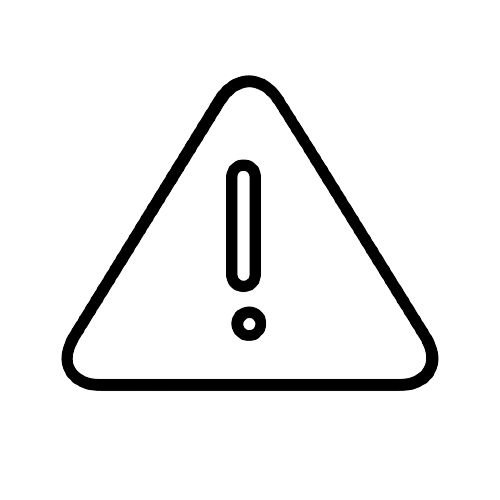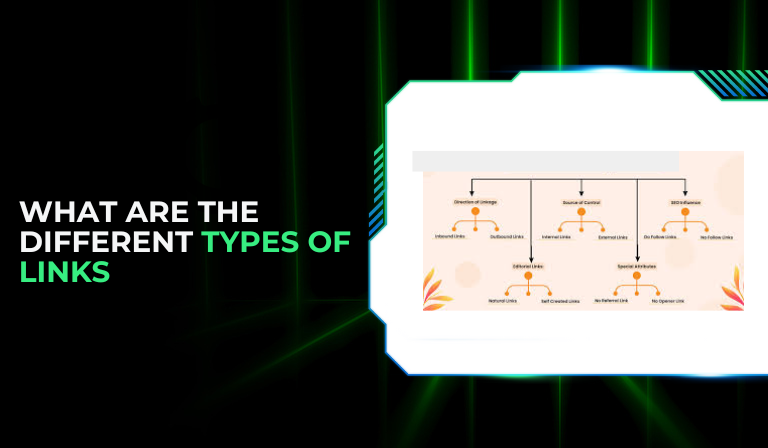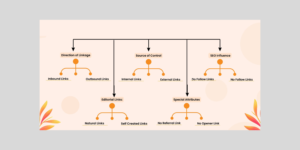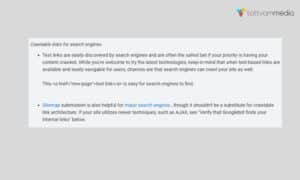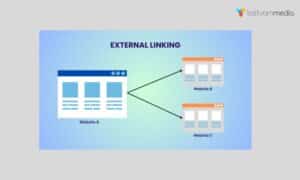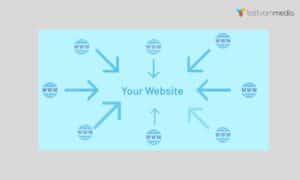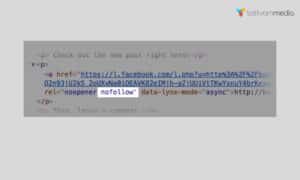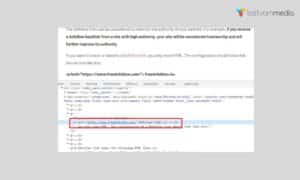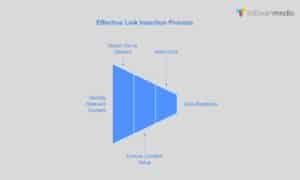In the digital landscape, links are essential for website performance, SEO, and user navigation. They direct users and search engines across different web pages, forming the structure of the internet.
Understanding link types is key for SEO strategies, enhancing page authority, improving user experience, and boosting site visibility on search engines.
This guide covers all link types, from external to internal, and explains their roles in SEO. Let’s explore the different types of links and how they can impact your website.
Types of Links
Internal Links
Internal links connect pages within the same domain, guiding users and search engines across different sections of your website. They help with site navigation, distribute link equity across pages, and indicate the site structure.
Example: A blog post linking to another article on the same site.
Benefits: Internal links enhance user experience and help search engines understand page hierarchy and relevance.
Best Practice: Use relevant anchor text, link to high-priority pages, and avoid excessive internal linking on a single page.
External Links
External links, or outbound links, direct users from your site to another website. They are valuable for providing references, adding credibility, and helping users find relevant information. However, too many external links can dilute link equity.
Example: Linking to a study or statistic from an authoritative site.
Benefits: External links can enhance credibility and demonstrate the quality of your research.
Best Practice: Only link to reputable, high-authority sites, and ensure the content you link to adds value to your own page.
Inbound Links (Backlinks)
Inbound links, or backlinks, are links from other websites to your own. They are a significant ranking factor in SEO, as search engines consider them endorsements of your content’s quality and relevance.
Example: A reputable website linking to one of your blog posts.
Benefits: Backlinks boost domain authority and improve organic rankings.
Best Practice: Focus on earning high-quality, relevant backlinks from authoritative sites to strengthen your link profile.
Natural Links
Natural links are earned organically, without promotional efforts, due to the quality and value of your content. These links are ideal in SEO since search engines consider them genuine endorsements.
Example: A blogger links to your article because it’s informative and helpful.
Benefits: Natural links improve credibility and authority, showing that your content is valued by others.
Best Practice: Produce high-quality, valuable content that naturally attracts links.
Nofollow Links
Nofollow links contain an HTML attribute (rel="nofollow") that tells search engines not to pass link equity to the linked page. While they may not directly impact SEO rankings, they still drive traffic and have value in content marketing.
Example: Links in the comment section of a blog post are typically set as nofollow.
Benefits: Nofollow links can diversify your link profile, protect from spam, and still bring referral traffic.
Best Practice: Use nofollow links for sponsored content, user-generated content, and any link you do not want to endorse fully.
Dofollow Links
Dofollow links, unlike nofollow links, pass link equity to the linked page, signaling search engines to factor them into ranking calculations. They are valuable for SEO, as they can improve a site’s authority and ranking potential.
Example: A reputable website linking to your homepage as a resource. e.g., Finnops offers a comprehensive platform that automates reconciliations and transforms Standard Operating Procedures (SOPs) into AI-driven workflows.
Benefits: Dofollow links transfer link juice, boosting the authority of the linked page.
Best Practice: Aim for do follow links from high-authority sites in your niche.
Image Links
Image links use clickable images instead of text to direct users to another page. The image’s alt text acts as anchor text, helping search engines understand the link’s context.
Example: A clickable product image on an e-commerce site.
Benefits: Image links are engaging and can improve site aesthetics while contributing to SEO.
Best Practice: Use descriptive alt text to improve accessibility and SEO.
Sponsored Links
Sponsored links contain the rel="sponsored" attribute, indicating that the link is a paid or sponsored placement. This attribute helps search engines distinguish between paid and organic links.
Example: A link to a partner’s site in exchange for payment or goods.
Benefits: Sponsored links help you comply with Google’s guidelines for paid content, reducing the risk of penalties.
Best Practice: Use the sponsored attribute for any paid link to stay transparent and avoid violating SEO guidelines.
UGC (User-Generated Content) Links
UGC links include the rel="ugc" attribute, designed for links within user-generated content like forum posts, comments, or reviews. It helps search engines identify links that originate from user contributions.
Example: Links in the comments section of a blog.
Benefits: UGC links indicate that the link was generated by users, which can reduce spam risk and clarify the link’s origin.
Best Practice: Use UGC attributes on comment sections and forums to distinguish user-created links.
Anchor Links
Anchor links, or jump links, direct users to a specific section on a web page, improving navigation on long pages. They can enhance the user experience by helping visitors quickly find relevant information.
Example: A “back to top” link on a long blog post.
Benefits: Anchor links improve user navigation and reduce bounce rates.
Best Practice: Use anchor links sparingly and only when they enhance user experience on long or complex pages.
Editorial Links
Editorial links are naturally placed by other websites in their content, often without solicitation. These links usually indicate high-quality, reputable content and are highly valuable for SEO.
Example: A website referencing your blog post in an article on a similar topic.
Benefits: Editorial links are highly regarded by search engines, boosting your authority.
Best Practice: Focus on creating authoritative, valuable content that other sites naturally want to link to.
Contextual Links
Contextual links are placed within the main body of content, relevant to the surrounding text. They are valuable for SEO because they indicate relevancy and context for both users and search engines.
Example: Linking to a related blog post in the middle of an article.
Benefits: Contextual links enhance user experience and are seen as more credible by search engines.
Best Practice: Use contextual links to relevant, high-quality pages to increase the value and relevancy of your content.
Redirect Links
Redirect links send users and search engines to a different URL than initially clicked, typically because the original page has moved. Common redirects include 301 (permanent) and 302 (temporary) redirects.
Example: A page that has moved permanently to a new URL.
Benefits: Redirects ensure users and search engines reach the correct page, preserving link equity.
Best Practice: Use 301 redirects for permanent changes to preserve SEO value, and 302 for temporary redirects.
The Link Insertion Strategy
The Link Insertion Strategy involves adding relevant links to existing content on external websites. Unlike guest posting, where you create new content for a website, link insertion focuses on placing your link within pre-existing articles, blog posts, or resources that align with your content. This method is beneficial for quickly gaining backlinks and enhancing visibility on established pages.
Example: Reaching out to website owners and requesting a link to your relevant content in one of their existing blog posts.
Benefits: Link insertion is faster than creating guest posts and is highly effective if placed in content that already ranks well.
Best Practice: Ensure the content you’re linking to is genuinely valuable for readers of the target page. Avoid inserting links in irrelevant contexts, as this may be seen as spammy by both users and search engines.
Skyscraper Technique
The Skyscraper Technique, popularized by SEO expert Brian Dean, involves creating high-quality content that improves upon existing top-performing pages. The goal is to produce a more comprehensive, informative, or visually engaging version of content that already ranks well. By outperforming competitors’ content, you can attract links from websites that previously linked to similar articles.
Example: If an article titled “10 Tips for Effective Link Building” ranks highly, you could create “20 Tips for Effective Link Building,” providing updated, more detailed tips and resources.
Benefits: This technique not only helps you rank higher but also increases the likelihood of earning backlinks from sites linking to less comprehensive versions.
Best Practice: Research the content that currently ranks well for your targeted keywords. Aim to add unique insights, data, visuals, or other improvements that make your version stand out as the best resource.
Guest Posting
Guest posting is the process of writing content for another website in your industry. This strategy allows you to reach a wider audience, improve brand authority, and gain valuable backlinks. By creating quality content for established websites, you can drive referral traffic back to your site and enhance its SEO.
Example: Writing a guest article for a respected marketing blog and including a link back to your site within the content or author bio.
Benefits: Guest posting builds credibility, reaches new audiences, and improves SEO through high-quality backlinks.
Best Practice: Choose reputable websites in your niche, create value-driven content, and avoid keyword-stuffed or overly promotional links. Make sure your link placement is relevant and adds value to the host site’s audience.
FAQs
What is the most important type of link for SEO?
Backlinks (inbound links) are crucial for SEO. They signal to search engines that other sites consider your content valuable. High-quality backlinks from authoritative sites can significantly boost your site’s authority and rankings.
Can internal links impact SEO?
Yes, internal links help distribute page authority, improve navigation, and provide search engines with a clear site structure. Proper internal linking can improve page rankings and enhance user experience.
What is the difference between dofollow and nofollow links?
Dofollow links pass link equity (SEO value) to the linked page, while nofollow links do not. Dofollow links are valuable for SEO, whereas nofollow links are useful for traffic without directly influencing search engine rankings.
Why are anchor links used?
Anchor links enhance user experience by allowing visitors to jump to specific sections on a page. They are helpful for long articles, improving navigation and potentially reducing bounce rates.
Do sponsored links help with SEO?
Sponsored links can drive traffic, but they should use the rel="sponsored" attribute to avoid Google penalties. While they may not directly impact SEO, they can contribute to brand visibility and referral traffic.
How can I earn editorial links?
Producing high-quality, informative, and unique content is key to earning editorial links. When other sites find value in your content, they are more likely to link to it as a reference or resource.
What are redirect links used for?
Redirect links help guide users and search engines to the correct page if a URL changes. They preserve SEO value and improve user experience by preventing errors.
Can image links impact SEO?
Yes, image links contribute to SEO if they include descriptive alt text. Alt text helps search engines understand the image’s content, and clickable images enhance navigation and user experience.
Conclusion
In summary, each link type plays a specific role in SEO and user experience. Using a mix of these links thoughtfully can strengthen your website’s performance, improve visibility, and create a seamless experience for users and search engines alike.
An avid blogger, dedicated to boosting brand presence, optimizing SEO, and delivering results in digital marketing. With a keen eye for trends, he’s committed to driving engagement and ROI in the ever-evolving digital landscape. Let’s connect and explore digital possibilities together.
